Gardens and Guanxi
Sunday 11 July 1999 – Wednesday 14 July
1999
 Shanghai
is about an hour from Xian by plane. All
of us remarked on how much like Hong Kong it appeared at first sight, with its
neon lights and a strikingly cosmopolitan feel.
As with Beijing, there was construction underway everywhere, but it did
not have the same stifling feel to it as the country’s capital, and was a
relatively pleasant city to explore on foot.
Shanghai
is about an hour from Xian by plane. All
of us remarked on how much like Hong Kong it appeared at first sight, with its
neon lights and a strikingly cosmopolitan feel.
As with Beijing, there was construction underway everywhere, but it did
not have the same stifling feel to it as the country’s capital, and was a
relatively pleasant city to explore on foot.
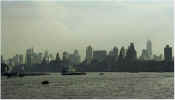 Our hotel overlooked the Bund,
an embankment which runs along the Huangpu
River, and on one of our days we ventured out on a three hour cruise to the
fringe of the China Sea (part of the Pacific Ocean). Despite
not having been able to complete our journey into China overland by train, we
nonetheless felt a sense of accomplishment at having reached our ultimate
destination, the eastern seaboard of Asia.
Our hotel overlooked the Bund,
an embankment which runs along the Huangpu
River, and on one of our days we ventured out on a three hour cruise to the
fringe of the China Sea (part of the Pacific Ocean). Despite
not having been able to complete our journey into China overland by train, we
nonetheless felt a sense of accomplishment at having reached our ultimate
destination, the eastern seaboard of Asia.
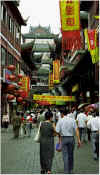 One
of our other main reasons for wanting to visit Shanghai was to start a collection of Yixing teapots. These
are renowned by tea connoisseurs worldwide for the quality of the clay as well
as the workmanship involved in making them; they come in all shapes, colours and
sizes and both of us were eager to select
One
of our other main reasons for wanting to visit Shanghai was to start a collection of Yixing teapots. These
are renowned by tea connoisseurs worldwide for the quality of the clay as well
as the workmanship involved in making them; they come in all shapes, colours and
sizes and both of us were eager to select  a few to take home as souvenirs.
Little did we realise how much we would fall in love with them and at the
end of our very first day in
Shanghai, we were proud owners of no less than 15! When we weren't
provoking a run on teapots, we strolled through markets old and new, visited teahouses, and generally took our time soaking in the atmosphere
of this amazing city.
a few to take home as souvenirs.
Little did we realise how much we would fall in love with them and at the
end of our very first day in
Shanghai, we were proud owners of no less than 15! When we weren't
provoking a run on teapots, we strolled through markets old and new, visited teahouses, and generally took our time soaking in the atmosphere
of this amazing city.
We
also took a day trip to Suzhou, about an hour from Shanghai, in order to visit
their famous gardens. Anyone who
knows Pippa’s mum will not be surprised at this given how many gardens she’s
visited in her lifetime but these were, in every shape and form, stunningly
different from those of Old Blighty. Suzhou
itself dates back some 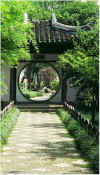 2,500 years, and by the
14th century was
China’s leading silk producer. Aristocrats,
scholars, actors and painters were all attracted to the city, constructing
villas and garden retreats for themselves.
It is these gardens, many of which still exist today, that attract
sightseers from around the world. They
are considered to be works of art – a fusion of nature, architecture, poetry
and painting - and are places for contemplation and relaxation.
There are a dozen or more gardens, some small, some large, and all with idiosyncratic
names such as “The Garden of the Master of Nets”, “The Garden for
Lingering In”, and “The Humble Administrator’s Garden”.
Each one is meant to be savoured at a snail’s pace, so with just a day
to spare, we selected four in which to spend our time.
2,500 years, and by the
14th century was
China’s leading silk producer. Aristocrats,
scholars, actors and painters were all attracted to the city, constructing
villas and garden retreats for themselves.
It is these gardens, many of which still exist today, that attract
sightseers from around the world. They
are considered to be works of art – a fusion of nature, architecture, poetry
and painting - and are places for contemplation and relaxation.
There are a dozen or more gardens, some small, some large, and all with idiosyncratic
names such as “The Garden of the Master of Nets”, “The Garden for
Lingering In”, and “The Humble Administrator’s Garden”.
Each one is meant to be savoured at a snail’s pace, so with just a day
to spare, we selected four in which to spend our time.
 Once
again, Eric had us on the earliest possible train out of Shanghai and once
again, we were grateful to have the chance to explore the first of our gardens
in peaceful seclusion, accompanied only by the odd individual undertaking their
morning ritual of shadow boxing or meditation.
After about an hour,
Once
again, Eric had us on the earliest possible train out of Shanghai and once
again, we were grateful to have the chance to explore the first of our gardens
in peaceful seclusion, accompanied only by the odd individual undertaking their
morning ritual of shadow boxing or meditation.
After about an hour, 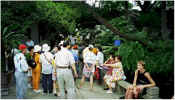 the onslaught of the Japanese and Chinese tourists
began: armed with loud speakers, cameras and whistles for attracting attention,
any peace and quiet we had been savouring was dispelled within minutes. It’s hard to contemplate life with
thousands of tourists milling around, but you can nonetheless soak up the
atmosphere and let your mind drift back to what it must have been like when
these amazing works of art were first designed.
All feature areas of water, covered walkways, inner and outer parts,
and an incredible use of space and scale that creates perspectives and
vistas that seem almost unreal.
the onslaught of the Japanese and Chinese tourists
began: armed with loud speakers, cameras and whistles for attracting attention,
any peace and quiet we had been savouring was dispelled within minutes. It’s hard to contemplate life with
thousands of tourists milling around, but you can nonetheless soak up the
atmosphere and let your mind drift back to what it must have been like when
these amazing works of art were first designed.
All feature areas of water, covered walkways, inner and outer parts,
and an incredible use of space and scale that creates perspectives and
vistas that seem almost unreal.
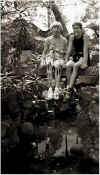
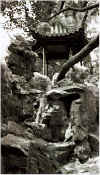
Impressed and inspired as we
were by these remarkable gardens, we had no choice but to pay a visit to Guilin
and cruise down the Li
River, to see for ourselves some of the dramatic scenery that had inspired these
timeless designs.